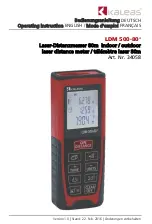
Section 8. Operation
311
which is the resolution used by PakBus clock-sync functions. In networks
without routers, repeaters, or retries, the communication time will cause an
additional error (typically a few 10s of milliseconds). PakBus clock
commands set the time at the end of a scan to minimize the chance of skipping
a record to a data table. This is not the same clock check process used by
LoggerNet
as it does not use average round trip calculations to try to account
for network connection latency.
4. An RF401 radio network has an advantage over Ethernet in that
ClockReport()
can be broadcast to all dataloggers in the network
simultaneiously. Each will set its clock with a single PakBus broadcast from
the master. Each datalogger in the network must be programmed with a
PakBusClock()
instruction.
Note
Use of PakBus clock functions re-synchronizes the
Scan()
instruction. Use
should not exceed once per minute. CR800 clocks drift at a slow enough rate that
a
ClockReport()
once per minute should be sufficient to keep clocks within 30
ms of each other.
With any synching method, care should be taken as to when and how things are
executed. Nudging the clock can cause skipped scans or skipped records if the
change is made at the wrong time or changed by too much.
5. GPS – clocks in CR800s can be synchronized to within about 10 ms of each
other using the
GPS()
instruction. CR800s built since October of 2008 (serial
numbers
≥
7920) can be synchronized within a few microseconds of each
other and within
≈
200 µs of UTC. While a GPS signal is available, the CR800
essentially uses the GPS as its continuous clock source, so the chances of
jumps in system time and skipped records are minimized.
6. Ethernet – any CR800 with a network connection (internet, GPRS, private
network) can synchronize its clock relative to Coordinated Universal Time
(UTC) using the
NetworkTimeProtocol()
instruction. Precisions are usually
maintained to within 10 ms. The NTP server could be another logger or any
NTP server (such as an email server or nist.gov). Try to use a local server —
something where communication latency is low, or, at least, consistent. Also,
try not to execute the
NetworkTimeProtocol()
at the top of a scan; try to ask
for the server time between even seconds.
8.2 Measurement and Control Peripherals
Peripheral devices expand the CR800 input / output capacity. Classes of
peripherals are discussed below according to use. Some peripherals are designed
as SDM (synchronous devices for measurement) devices. SDM devices are
intelligent peripherals that receive instruction from and send data to the CR800
over a proprietary, three-wire serial communications link utilizing channels C1,
C2 and C3.
Read More!
For complete information on available measurement and control
peripherals, go to the appendix Sensors and Peripherals
,
www.campbellsci.com
, or
contact a Campbell Scientific applications engineer.
Summary of Contents for CR850
Page 2: ......
Page 4: ......
Page 6: ......
Page 26: ...Table of Contents 26...
Page 30: ...Section 2 Cautionary Statements 30...
Page 32: ...Section 3 Initial Inspection 32...
Page 35: ...Section 4 Quickstart Tutorial 35 Figure 2 Wiring panel...
Page 55: ...Section 4 Quickstart Tutorial 55 Figure 24 PC200W View data utility...
Page 78: ...Section 5 System Overview 78...
Page 80: ...Section 6 CR800 Specifications 80...
Page 267: ...Section 7 Installation 267 Figure 84 Running average signal attenuation...
Page 268: ...Section 7 Installation 268...
Page 384: ...Section 8 Operation 384 Figure 113 Using the keyboard display...
Page 387: ...Section 8 Operation 387 Figure 116 Real time custom...
Page 388: ...Section 8 Operation 388 8 8 1 3 Final Storage Tables Figure 117 Final storage tables...
Page 389: ...Section 8 Operation 389 8 8 2 Run Stop Program Figure 118 Run Stop Program...
Page 390: ...Section 8 Operation 390 8 8 3 File Display Figure 119 File display...
Page 396: ...Section 8 Operation 396...
Page 402: ...Section 9 Maintenance 402...
Page 450: ...Section 11 Glossary 450...
Page 504: ...Appendix A CRBasic Programming Instructions 504...
Page 526: ...Appendix B Status Table and Settings 526...
Page 530: ...Appendix C Serial Port Pinouts 530...
Page 536: ...Appendix E FP2 Data Format 536...
Page 550: ...Appendix F Other Campbell Scientific Products 550...
Page 565: ......
















































